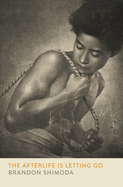
Writer and poet Brandon Shimoda's The Afterlife Is Letting Go brilliantly examines the aftermath of the incarceration of Japanese Americans during World War II, particularly the effects on descendants of the imprisoned. While Shimoda's PEN Open Book Award-winning The Grave on the Wall was an intimate search for his incarcerated grandfather, Afterlife is a more expansive, polyphonic companion.
Seven of the 23 chapters, for example, are "choral," a literal gathering of voices "composed of responses [from] over 250 descendants." One chapter compiles recollections of when they first learned, through books or in school, about the incarcerations. Three descendants share teachers' reactions: Oscar nominee Renee Tajima-Peña's teacher screamingly accused her of "lying" during her report about her family's imprisonment, filmmaker Rea Tajiri's teacher asked her to confirm that imprisonment "was like a vacation for Japanese Americans," and still another descendant's teacher wept quietly through her oral report.
Multiple essays exposing suicides and murders by guards powerfully stand out. Shimoda's most intimate pieces linger longest--a talk at the Holocaust History Center in Tucson, Ariz.; crying while reading certain books with his young daughter. His longed-for grandfather also bookends this title: Shimoda Midori photographed the cover image, and he reappears at the collection's end in his own words with the remarkable discovery, 80 years later, of some 30 letters--scalpel-redacted, stamped with "DETAINED ENEMY ALIEN MAIL EXAMINED"--sent while incarcerated to his sister-in-law, "free in Utah." Personal and public history haunt throughout, and with literary wizardry, Brandon Shimoda brilliantly connects the past to ongoing acts of police brutality, mental health abuses, and inhumane detentions. Accepting injustice is never an option. --Terry Hong

